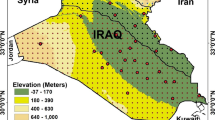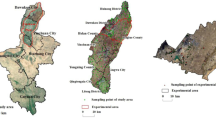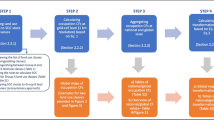Abstract
The current challenge in sustainable agriculture is to introduce new cropping systems to reduce pesticides use in order to reduce ground and surface water contamination. However, it is difficult to carry out in situ experiments to assess the environmental impacts of pesticide use for all possible combinations of climate, crop, and soils; therefore, in silico tools are necessary. The objective of this work was to assess pesticides leaching in cropping systems coupling the performances of a crop model (STICS) and of a pesticide fate model (MACRO). STICS-MACRO has the advantage of being able to simulate pesticides fate in complex cropping systems and to consider some agricultural practices such as fertilization, mulch, or crop residues management, which cannot be accounted for with MACRO. The performance of STICS-MACRO was tested, without calibration, from measurements done in two French experimental sites with contrasted soil and climate properties. The prediction of water percolation and pesticides concentrations with STICS-MACRO was satisfactory, but it varied with the pedoclimatic context. The performance of STICS-MACRO was shown to be similar or better than that of MACRO. The improvement of the simulation of crop growth allowed better estimate of crop transpiration therefore of water balance. It also allowed better estimate of pesticide interception by the crop which was found to be crucial for the prediction of pesticides concentrations in water. STICS-MACRO is a new promising tool to improve the assessment of the environmental risks of pesticides used in cropping systems.






Similar content being viewed by others
References
Alletto L, Pot V, Giuliano S, Costes M, Perdrieux F, Justes E (2015) Temporal variation in soil physical properties improves the water dynamics modeling in a conventionally-tilled soil. Geoderma 243–244:18–28
Aubertot J-N, Barbier J-M, Carpentier A, Gril J-J, Guichard L, Lucas P, Savary S, Voltz M, Savini I (2005) Pesticides, agriculture and the environment. Reducing the use of pesticides and limiting their environmental impact. Executive Summary of the expert Report written by INRA and Cemagref in response to a request from the Ministry of Agriculture and Fishery and the Ministry of Ecology and Sustainable Development http://inra.dam.front.en.pad.brainsonic.com/ressources/afile/234234-edd08-resource-expert-report-on-pesticides-summary.html. Accessed 2 May 2016
Beltman WHJ, Boesten JJTI, van der Zee SEATM (2008) Spatial moment analysis of transport of nonlinearly adsorbing pesticides using analytical approximations. Water Resour Res 44:W05417
Beulke S, Renaud F, Brown C (2002) Development of guidance on parameter estimation for the preferential flow model MACRO 4.2. Final Report of the DEFRA project PL0538. Cranfield Centre for EcoChemistry. University of Cranfield, UK
Bockstaller C, Guichard L, Keichinger O, Girardin P, Galan M-B, Gaillard G (2009) Comparison of methods to assess the sustainability of agricultural systems. A review. Agron Sustain Dev 29:223–235
Bohanec M, Messéan A, Scatasta S, Angevin F, Griffiths B, Krogh PH, Žnidaršič M, Džeroski S (2008) A qualitative multi-attribute model for economic and ecological assessment of genetically modified crops. Ecol Model 215:247–261
Brisson N (2008) Conceptual basis, formalisations and parameterization of the STICS crop model. Éditions Quæ, Versailles
Brisson N, Mary B, Ripoche D, Jeuffroy MH, Ruget F, Nicoullaud B, Gate P, Devienne-Barret F, Antonioletti R, Durr C, Richard G, Beaudoin N, Recous S, Tayot X, Plenet D, Cellier P, Machet JM, Meynard JM, Delécolle R (1998) STICS: a generic model for the simulation of crops and their water and nitrogen balances. Theory and parameterization applied to wheat and corn Agronomie 18:311–346
Brisson N, Gary C, Justes E, Roche R, Mary B, Ripoche D, Zimmer D, Sierra J, Bertuzzi P, Burger P, Bussière F, Cabidoche YM, Cellier P, Debaeke P, Gaudillère JP, Hénault C, Maraux F, Seguin B, Sinoquet H (2003) An overview of the crop model STICS. Eur J Agron 18:309–332
Brown CD, Dubus IG, Fogg P, Spirlet M, Gustin C (2004) Exposure to sulfosulfuron in agricultural drainage ditches: field monitoring and scenario-based modelling. Pest Manage Sci 60:765–776
Butault JP, Dedryver CA, Gary C, Guichard L, Jacquet F, Meynard JM, Nicot P, Pitrat M, Reau R, Sauphanor B, Savini I, Volay T (2010) Ecophyto R&D. Which options to reduce pesticide use? Executive Summary of the expert Report written by INRA, Parishttp://inra.dam.front.en.pad.brainsonic.com/ressources/afile/224993-8c054-resource-ecophyto-r-d-8-pages.html. Accessed 2 May 2016
Cattan P, Voltz M, Cabidoche YM, Lacas JG, Sansoulet J (2007) Spatial and temporal variations in percolation fluxes in tropical Andosol influenced by banana cropping patterns. J Hydrol 335:157–169
Cessna AJ, Elliott JA, Bailey J (2012) Leaching of three imidazolinone herbicides during sprinkler irrigation. J Environ Qual 41:882–892
Chikowo R, Faloya V, Petit S, Munier-Jolain NM (2009) Integrated Weed Management systems allow reduced reliance on herbicides and long-term weed control. Agric Ecosyst Environ 132:237–242
Climatik (2015) https://internet.inra.fr/climatik/. Accessed 10 February 2016
Constantin J, Willaume M, Murgue C, Lacroix B, Therond O (2015) The soil-crop models STICS and AqYield predict yield and soil water content for irrigated crops equally well with limited data. Agric For Meteorol 206:55–68
Coucheney E, Buis S, Launay M, Constantin J, Mary B, García de Cortázar-Atauri I, Ripoche D, Beaudoin N, Ruget F, Andrianarisoa KS, Le Bas C, Justes E, Léonard J (2015) Accuracy, robustness and behavior of the STICS soil-crop model for plant, water and nitrogen outputs: evaluation over a wide range of agro-environmental conditions in France. Environ Model Soft 64:177–190
Development Core Team R (2015) R: a language and environment for statistical computing. R Foundation for Statistical Computing
Directive 2009/128/EC (2009) Directive of the European parliament and of the council of 21 October 2009 establishing a framework for Community action to achieve the sustainable use of pesticides. Off J Eur Union, L309/71
Directive 98/83/EC (1998) Council directive of 3 November 1998 on the quality of water intended for human consumption. Off J Eur Union, L330/32
Dogliotti S, Rossing WA, van Ittersum M (2004) Systematic design and evaluation of crop rotations enhancing soil conservation, soil fertility and farm income: a case study for vegetable farms in South Uruguay. Agric Syst 80:277–302
Dubus IG, Brown CD, Beulke S (2003) Sensitivity analyses for four pesticide leaching models. Pest Manage Sci 59:962–982
FAO (2014) World reference base for soil resources 2014 international soil classification system for naming soils and creating legends for soil maps. FAO, Rome
FOCUS (2000) FOCUS groundwater scenarios in the EU review of active substances. Report of the FOCUS Groundwater Scenarios Workgroup, EC document reference Sanco/321/200 rev.2
Gabrielle B, Roche R, Angas P, Cantero-Martinez C, Cosentino L, Mantineo M, Langensiepen M, Hénault C, Laville P, Nicoullaud B, Gosse G (2002) A priori parameterisation of the CERES soil-crop models and tests against several European data sets. Agronomie 22:119–132
Gerke HH, van Genuchten MT (1996) Macroscopic representation of structural geometry for simulating water and solute movement in dual-porosity media. Adv Water Resour 19:343–357
Giannouli DD, Antonopoulos VZ (2015) Evaluation of two pesticide leaching models in an irrigated field cropped with corn. J Environ Manage 150:508–515
Jacobsen CS, van der Keur P, Iversen BV, Rosenberg P, Barlebo HC, Torp S, Vosgerau H, Juhker RK, Ernstsen V, Rasmussen J, Brinch UC, Jacobsen OH (2008) Variation of MCPA, metribuzine, methyltriazine-amine and glyphosate degradation, sorption, mineralization and leaching in different soil horizons. Environ Pollut 156:794–802
Jarvis N, Lindahl A, Messing I, Stenemo F, Hollis J, Reichenberger S, Dubus IG (2007) Algorithm to completely parameterise MACRO from basic soil property data. Report DL21 of the FP6 EU-funded FOOTPRINT project
Jégo G, Pattey E, Bourgeois G, Morrison MJ, Drury CF, Tremblay N, Tremblay G (2010) Calibration and performance evaluation of soybean and spring wheat cultivars using the STICS crop model in Eastern Canada. Field Crops Res 117:183–196
Larsbo M, Roulier S, Stenemo F, Kasteel R, Jarvis N (2005) An improved dual-permeability model of water flow and solute transport in the vamoose zone. Vadose Zone J 4:398–406
Lemaire G, van Oosterom E, Jeuffroy M-H, Gastal F, Massignam A (2008) Crop species present different qualitative types of response to N deficiency during their vegetative growth. Field Crops Res 105:253–265
Lichtfouse E, Navarrete M, Debaeke P, Souchère V, Alberola C, Ménassieu J (2009) Agronomy for sustainable agriculture: a review. Agron Sustain Dev 29:1–6
Louie MJ, Shelby PM, Smesrud JS, Gatchell LO, Selker JS (2000) Field evaluation of passive capillary samplers for estimating groundwater recharge. Water Resour Res 36:2407–2416
Marín-Benito JM, Pot V, Alletto L, Mamy L, Bedos C, Barriuso E, Benoit P (2014) Comparison of three pesticide fate models with respect to the leaching of two herbicides under field conditions in an irrigated maize cropping system. Sci Tot Environ 499:533–545
McGrath GS, Hinz C, Murugesu S (2009) A preferential flow leaching index. Water Resour Res 45:W11405
Meynard JM (2008) To produce differently: to reinvent cropping systems. In: Reau R, Doré T (eds) Innovative and sustainable cropping systems: which methods for conception and assessment? Éducagri éditions/AgroParisTech, Paris, pp 11–27 (in French)
Milan M, Ferrero A, Fogliatto S, Piano S, Vidotto F (2015) Leaching of S-metolachlor, terbuthylazine, desethyl-terbuthylazine, mesotrione, flufenacet, isoxaflutole, and diketonitrile in field lysimeters as affected by the time elapsed between spraying and first leaching event. J Environ Sci Health, Part B 50:851–861
Moeys J, Larsbo M, Bergström L, Brown CD, Coquet Y, Jarvis N (2012) Functional test of pedotransfer functions to predict water flow and solute transport with the dual-permeability model MACRO. Hydrol Earth Syst Sci 16:2069–2083
Mortensen DA, Bastiaans L, Sattin M (2000) The role of ecology in the development of weed management systems: an outlook. Weed Res 40:49–62
Mottes C, Lesueur-Jannoyer M, Le Bail M, Malézieux E (2014) Pesticide transfer models in crop and watershed systems: a review. Agron Sustain Dev 34:229–250
Penman HL (1948) Natural evaporation from open water, bare soil and grass. Proc R Soc Lond 193:120–46
PPDB (2016) The FOOTPRINT Pesticide Properties DataBase. University of Hertfordshire, UK, http://sitem.herts.ac.uk/aeru/ppdb/en/atoz.htm. Accessed 2 May 2016
Queyrel W, Habets F, Blanchoud H, Ripoche D, Launay M (2016) Pesticide fate modelling in soils with the crop model STICS: feasibility for assessment of agricultural practices. Sci Tot Environ 542:787–802
Ricci P, Lamine C, Messéan A (2011) The integrated pest management: a necessary paradigm shift. Agron Environ Soc 1:22–30
Sadok W, Angevin F, Bergez JE, Bockstaller C, Colomb B, Guichard L, Reau R, Messéan A, Doré T (2009) MASC, a qualitative multi-attribute decision model for ex ante assessment of the sustainability of cropping systems. Agron Sustain Dev 29:447–461
Smith J, Smith P, Addiscott T (1996) Quantitative methods to evaluate and compare soil organic matter (SOM) models. NATO ASI Series I 38:181–199
Ugarte-Nano CC (2015) Study of the variability of physic and hydrodynamic properties of a clayey soil under the effect of Integrated Weed Management in cropping systems. PhD thesis, Université de Bourgogne (in French)
Ugarte-Nano CC, Nicolardot B, Ubertosi M (2015) Near-saturated hydraulic conductivity measured on a swelling silty clay loam for three integrated weed management based cropping systems. Soil Till Res 150:192–200
Ugarte-Nano CC, Nicolardot B, Quinche M, Munier-Jolain N, Ubertosi M (2016) Effects of integrated weed management based cropping systems on the water retention of a silty clay loam soil. Soil Till Res 156:74–82
van Genuchten MT, Leij F, Yates SR (1991) The RETC code for quantifying hydraulic functions of unsaturated soils. Technical Report IAG-DW 12933934, US Salinity Laboratory, US Department of Agriculture, Agricultural Research Service, Riverside, CA
Vanclooster M, Boesten J, Trevisan M, Brown CD, Capri E, Eklo OM, Gottesbüren B, Gouy V, Van der Linden AMA (2000) A European test of pesticide-leaching models: methodology and major recommendations. Agric Water Manage 44:1–19
Acknowledgments
The authors are grateful to Pascal Farcy (INRA, UE Domaine d’Epoisses, Bretenière), Simon Giuliano, Gaël Rametti and François Perdrieux (INP-EI Purpan – UMR 1248 AGIR, Lamothe), and Arnaud Coffin and Frédéric Lombard (Université Bourgogne Franche-Comté, AgroSup Dijon, UMR 1347 Agroécologie) for providing field experimental data. They also thank Nick Jarvis for his help in developing the unofficial release of MACRO. This project was supported by the research program “For the Ecophyto plan (PSPE1)” funded by the French Ministry in charge of Agriculture (Perform project), by the research program “Assessing and reducing environmental risks from plant protection products” funded by the French Ministries in charge of Ecology and Agriculture (Ecopest project), and by the French Ministry in charge of Agriculture and by ONEMA (System-Eco-Puissance4 project). The field experiments are part of the DEPHY network. Sabine-Karen Lammoglia was supported by INRA (National Institute for Agricultural Research) (SMASH metaprogramme) and by the Perform project.
Author information
Authors and Affiliations
Corresponding author
Additional information
Responsible editor: Marcus Schulz
Rights and permissions
About this article
Cite this article
Lammoglia, SK., Moeys, J., Barriuso, E. et al. Sequential use of the STICS crop model and of the MACRO pesticide fate model to simulate pesticides leaching in cropping systems. Environ Sci Pollut Res 24, 6895–6909 (2017). https://doi.org/10.1007/s11356-016-6842-7
Received:
Accepted:
Published:
Issue Date:
DOI: https://doi.org/10.1007/s11356-016-6842-7




